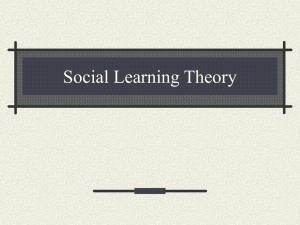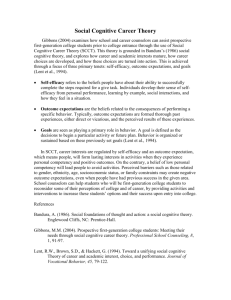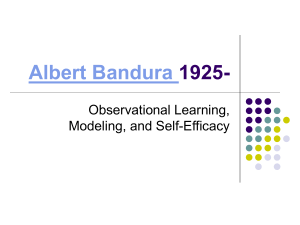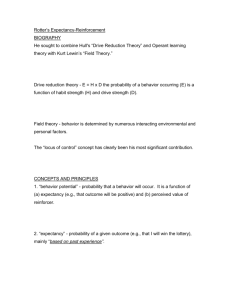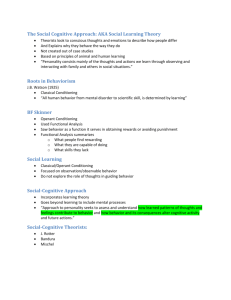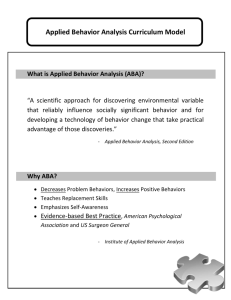Focus of social cognitive theory is learning by observation and
advertisement
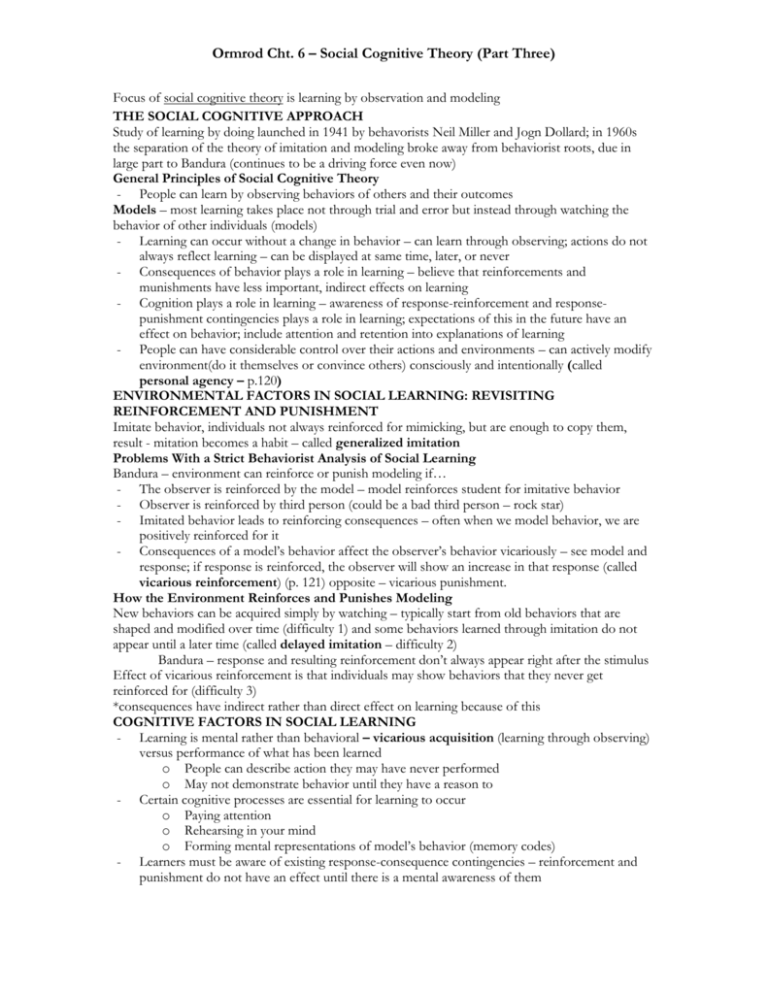
Ormrod Cht. 6 – Social Cognitive Theory (Part Three) Focus of social cognitive theory is learning by observation and modeling THE SOCIAL COGNITIVE APPROACH Study of learning by doing launched in 1941 by behavorists Neil Miller and Jogn Dollard; in 1960s the separation of the theory of imitation and modeling broke away from behaviorist roots, due in large part to Bandura (continues to be a driving force even now) General Principles of Social Cognitive Theory - People can learn by observing behaviors of others and their outcomes Models – most learning takes place not through trial and error but instead through watching the behavior of other individuals (models) - Learning can occur without a change in behavior – can learn through observing; actions do not always reflect learning – can be displayed at same time, later, or never - Consequences of behavior plays a role in learning – believe that reinforcements and munishments have less important, indirect effects on learning - Cognition plays a role in learning – awareness of response-reinforcement and responsepunishment contingencies plays a role in learning; expectations of this in the future have an effect on behavior; include attention and retention into explanations of learning - People can have considerable control over their actions and environments – can actively modify environment(do it themselves or convince others) consciously and intentionally (called personal agency – p.120) ENVIRONMENTAL FACTORS IN SOCIAL LEARNING: REVISITING REINFORCEMENT AND PUNISHMENT Imitate behavior, individuals not always reinforced for mimicking, but are enough to copy them, result - mitation becomes a habit – called generalized imitation Problems With a Strict Behaviorist Analysis of Social Learning Bandura – environment can reinforce or punish modeling if… - The observer is reinforced by the model – model reinforces student for imitative behavior - Observer is reinforced by third person (could be a bad third person – rock star) - Imitated behavior leads to reinforcing consequences – often when we model behavior, we are positively reinforced for it - Consequences of a model’s behavior affect the observer’s behavior vicariously – see model and response; if response is reinforced, the observer will show an increase in that response (called vicarious reinforcement) (p. 121) opposite – vicarious punishment. How the Environment Reinforces and Punishes Modeling New behaviors can be acquired simply by watching – typically start from old behaviors that are shaped and modified over time (difficulty 1) and some behaviors learned through imitation do not appear until a later time (called delayed imitation – difficulty 2) Bandura – response and resulting reinforcement don’t always appear right after the stimulus Effect of vicarious reinforcement is that individuals may show behaviors that they never get reinforced for (difficulty 3) *consequences have indirect rather than direct effect on learning because of this COGNITIVE FACTORS IN SOCIAL LEARNING - Learning is mental rather than behavioral – vicarious acquisition (learning through observing) versus performance of what has been learned o People can describe action they may have never performed o May not demonstrate behavior until they have a reason to - Certain cognitive processes are essential for learning to occur o Paying attention o Rehearsing in your mind o Forming mental representations of model’s behavior (memory codes) - Learners must be aware of existing response-consequence contingencies – reinforcement and punishment do not have an effect until there is a mental awareness of them Ormrod Cht. 6 – Social Cognitive Theory (Part Three) - Learners form expectations for future response-consequence contingencies – people perform based on their understanding of punishments and rewards (outcome expectations – hypothesis about the results that future actions are likely to bring; p. 123) and behave to receive the reinforcers o Incentive – anticipating that a particular reinforcement will occur if a particular behavior is performed (123). Expectation of reinforcement (incentive) influences the learning of a behavior it proceeds - Learners form beliefs about their abilities to perform behaviors (efficacy expectations – beliefs about whether they themselves can execute particular behaviors successfully; p. 124) - Outcome and efficacy expectations influence cognitive processes that promote learners – depends on belief that action will lead to reinforcement - The nonoccurrence of expected consequences is an influential consequences – evokes strong emotional response – when people see others misbehave with no consequence, they are more likely to misbehave as well RECIPROCAL CAUSATION - Behavior influences environment and the person A consequence affects if behavior will happen again, but the persons perception of the environment (a “person” variable) can influence behavior, too – responses made determine the learning opportunities they have as well as the consequences (126); pattern of responses affects confidence and expectations for future success (more person variables) “By directing attention (a person variable) to one stimulus and not to another, certain aspects of the environment will be experienced and others will not. And we have already seen the consequences of past behavior (environmental variable) affect the expectations that people have (a person variable) regarding the outcomes of future behaviors” (p. 126). MODELING - How Modeling Affects Behavior - Teaches new behaviors through observation - Influences frequency of reinforced behaviors – vicarious reinforcement has a facilitation effect – less likely to do behaviors that others have been punished for (vicarious punishment has an inhibition effect) Can encourage previously forbidden behaviors – if model is reinforced for previously “wrong” behavior, they are more likely to follow this (vicarious reinforcement also has a disinhibition effect) - Increases frequency of similar (rather than identical) behavior Characteristics of Effective Models - live model – actual person; symbolic model – book film or television; verbal instructions – descriptions of how to behave - Model are most likely competent; have prestige and power; behave in stereotypical “genderappropriate” ways; and relevant to the observer’s situation (similar to themselves; functional value in their lives) Behaviors That Can Be Learned By Modeling - Academic skills o “And students’ general attitudes toward school and academic achievement are influenced bt rhe peers with whom they regularly associate” (J.R. Harris, 1998, p. 130 in Ormrod) o cognitive modeling – students learn academic skills fore effectively when models demonstrate how to do and think about something - Aggression (if they watch violent TV or movies, will be more violent, and vice versa) - Morality (especially in terms of prosocial behaviors, or those that help other’s well-being) *more likely to imitate what the model does than what the model says; models must practice what they preach Conditions Necessary for Effective Modeling to Occur Ormrod Cht. 6 – Social Cognitive Theory (Part Three) (Bandura) – four conditions needed for effective modeling: attention, retention, motor reproduction, motivation - Attention – pay attention to model and aspects of behavior - Retention – remember what has been seen through rehearsal (repeat what needs to be remembered over and over again); visual images of behaviors they have seen (memory codes) that serve as guides when later doing the behavior – learning from a model is easier if there is assistance in forming memory codes for observable behavior - Motor Reproduction – actual replication – need an opportunity to perform behavior as they observe (allows for visual, verbal and motoric encoding of the behavior) – allows for feedback from the model - Motivation- model behaviors when motivated to do so; varies between individuals, so modeling of same behavior will be different; involves self-efficacy as well Absence of any of these makes modeling unlikely to occur SELF-EFFICACY self-efficacy - people’s beliefs about their own ability to execute various behaviors successfully (118) self concept: “Who am I?” self-esteem: “How good am I as a person?” self-efficacy: “How well can I do…”refers to learner’s beliefs about their competence of a specific action/domain How Self-Efficacy Affects Behavior - Choice of Activities (do tasks they think they can succeed in; avoid ones they think they will fail in) - Goals – high self efficacy, high goals - Effort and persistence – high self-efficacy, more effort & persistence when encountering obstacles - Learning and Achievement – high self efficacy, high chance of achieving (even if self-esteem is low) needs to be ACCURATE & REASONABLE to capitalize on strengths and weaknesses self-efficacy for learning (I can learn it if I put my mind to it) – should be more optimistic self efficacy for performance (I already know how to do this) – should be in line with current ability levels Factors in the Development of Self-Efficacy - Previous successes and failures more self efficacy (confidence) if they’ve done it and succeeded with it in the past (judgments based on performance in comparison with peers or the progress they make over time) resilient self-efficacy – when historically successful people have encountered setbacks in the past, they learn that sustained effort and perseverance are key ingredients for success (Bandura, 1989; Ormrod p 138) - Messages from others – enhanced when others praise performance or say success is possible – short-lived until it becomes a reality (good example with constructive criticism on p 138) - Successes and Failures of others – self-efficacy informed through observing failures and successes of others like themselves coping model – a peer model who struggles with a task at first then gradually masters it shows that success takes work, and see strategies used - Successes and Failures of the Group as a Whole – may have greater self-efficacy in group and when they achieve success as a group (collective self-efficacy) – due to perceptions of how well they can work responsibly and organizationally together SELF-REGULATION Through reinforcement and punishment, learn about acceptable behavior and develop own ideas about this behavior, and they choose actions accordingly. Elements of Self-Regulation - Setting standards and goals- establish criteria of “acceptable” performance to direct behavior towards – based on what other people adopt and behavior of models; most apt to adapt goals similar to models they relate to - Self-observation – be aware of how they are doing at present- what works well, what needs improvement Ormrod Cht. 6 – Social Cognitive Theory (Part Three) - Self-Evaluation – judge and evaluate behavior based on self-created standards and goals - Self-reaction – begin reinforcing themselves when accomplish goals; punish self when not meeting self-chosen performance standards (can be as influential as reinforcement and punishments given by others) Promoting Self-Regulated Behavior - Self-instructions – teach learners to repeat self-instructions to guide behavior (141) – helps students “acquire more effective approachesto academic tasks, develop better social skills, and keep their impulsive and aggressive behavior in check” (Alberto & Troutman… see p. 142) Meichenbaum’s 5 steps in teaching children how to give self-instructions to guide their behavior 1) Cognitive Modeling – adult model performs desired task while verbalizing instructions that guide performance 2) Overt, external guidance – child performs tasks while listening to the adult verbalize the instructions 3) Overt self-guidance – child repeats instruction aloud while performing task 4) Faded, overt self-guidance – The child repeats instruction aloud while performing the task 5) Covert self-instruction – child silently thinks about instructions while performing the child (figure 6.2, p. 142) - Self-monitoring- observe and assess own responses (can easily alter the frequency of behavior); undesirable behaviors can be decreased; learners become aware of how frequently they engage in “bad” behavior and can lead to behavior improvement (see p143 for direct quote of research) - Self-reinforcement – change behavior through giving self a treat or special privilege when they behave in a desired fashion and withholding reinforcement when they do not (LOTS of people cited – see p. 143) – when students learn to reinforce themselves for accomplishments, study habits and academic performance improves (lots of people again – p. 143) - Self-imposed stimulus control – a response is under stimulus control when it is emitted in the presence of some stimuli but not in the presence of others, can promote self-regulation – can seek out an environment where this will best occur – only works when students are motivated to change their behavior learners have some control over their behavior and their environment. Three warnings – must have capability for performing desired behavior, must be cautioned not to expect too much of themselves too quickly, must believe they can make the necessary behavior changes (self-efficacy) The Cognitive Side of Self-Regulation (Meichenbaum’s final step: the learner thinks about instructions a model has provided – control of mental processes is called self-regulated learning as well as self-regulated behavior) EDUCATIONAL IMPLICATIONS OF SOCIAL COGNITIVE THEORY - Students learn a great deal by observing others (must be consistent in rewards and punishments) - Describing consequences of behaviors can increase appropriate ones and decrease inappropriate ones - Modeling provides an alternative to shaping for teaching new behaviors - Teachers, parents and other adults must model appropriate behaviors and take care that they don’t model inappropriate ones (includes attitudes) - Exposure to a variety of other models further enhances students’ learning (carefully chosen models can help to “break down traditional stereotypes regarding what different groups of people can and cannot do” (Ormrod 146) - Students must believe they are capable of accomplishing school tasks (changing self-efficacy is easier than changing self-concepts or self-esteem; can create generalized self-efficacy – applies broadly to many areas of school curriculum – p.147) - Teachers should help students set realistic expectations for accomplishments (help form optimistic, realistic self-expectations based on current ability level & available instruction and support) - Self-regulation techniques provide effective models for improving student behavior Ormrod Cht. 6 – Social Cognitive Theory (Part Three)

